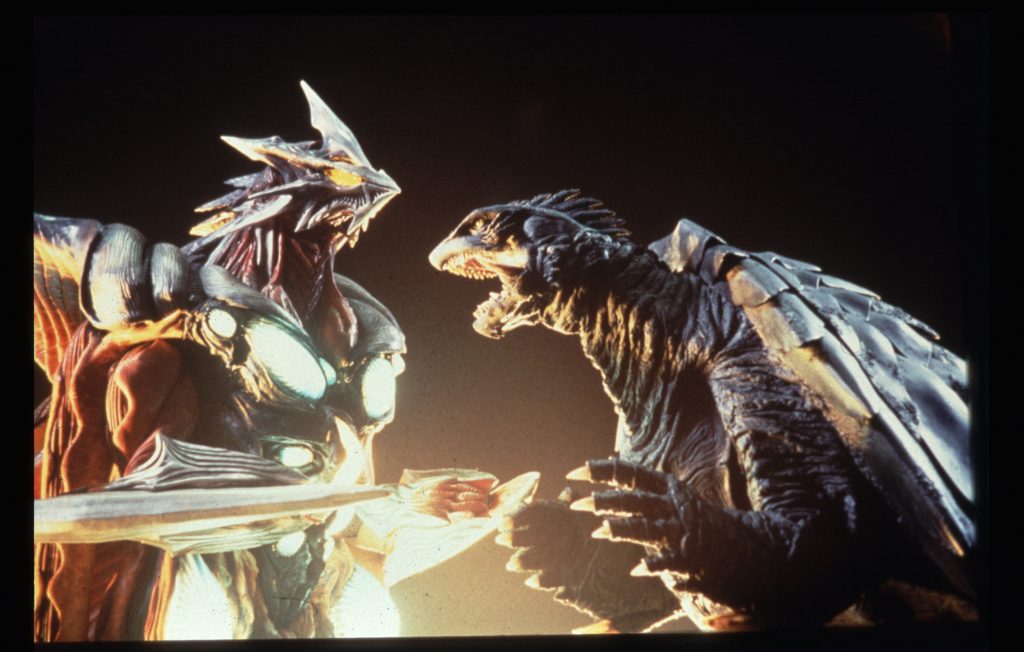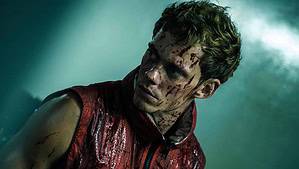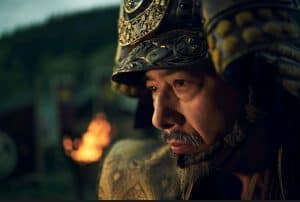After laying dormant for fifteen years, Gamera was rebooted for the big screen in a smash hit trilogy masterminded by director Shusuke Kaneko (Necronomicon), writer Kazunori Ito (Ghost in the Shell) and SFX director Shinji Higuchi (who went on to co-direct Shin Godzilla). Trading the campy kid-friendly surrealism of the earlier films for a darker, more realistic tone and jaw-dropping innovative special effects, the “Heisei trilogy” are still regarded today as three of the best – if not the very best – kaiju films ever made. This unmissable trio is complimented by a bonus disc featuring Gamera the Brave, a heartwarming mix of family-friendly adventure and cutting-edge kaiju action that is the most recent Gamera film to date.

Disc One
Gamera: The Guardian of the Universe (1995)
After laying dormant for fifteen years, Gamera was rebooted for the big screen just in time for his 30th anniversary, thanks to director Shusuke Kaneko (Necronomicon), writer Kazunori Ito (Ghost in the Shell) and SFX director Shinji Higuchi (who went on to co-direct Shin Godzilla). Now a guardian deity, Gamera tussles with a new incarnation of his old foe – the flying monster Gyaos – first in Fukuoka, and then in a spectacular aerial battle over Tokyo. Two young women – a plucky scientist and a teenage girl with a psychic link to Gamera – try to convince the people around them that Gamera is not a threat to humanity, but rather its last hope.
Much like Gamera needs to rest after being grievously injured, the franchise as a whole needed to rest after ending the Showa Era on a down note that presented a new low even for this series. After a fifteen year respite, the big guy roared back to life with a new beginning that reinvigorated the series substantially. Whereas the “friend to all children” became something almost exclusively for the younger crowd in the latter half of the previous era, this new trilogy put respect back on Gamera’s name. From the opening moments, you can feel the seriousness of the situation through the score from Kow Otani. The producers also brought a bigger spectacle to the narrative via some carefully implemented special effects. These may mostly still be people in suits, but the quality is markedly better in all respects. There are still aspects where Gamera is connected with younger human characters, but they are written to be way less obnoxious. The eternal struggle of Gamera vs. Gyaos is portrayed in a really thrilling manner that makes this one of the more enjoyable kaiju movies out there.

Disc Two
Gamera 2: Attack of Legion (1996)
One year after the events of the previous film, Earth’s ecosystem is under attack by an insect lifeform from outer space bent on colonizing our world. As the city of Sendai is destroyed, Gamera must protect the planet from the monster Legion and get some help from Japan’s Self Defense Forces. Following the smash success of the first film in the trilogy, Gamera 2: Attack of Legion brings the dream team of director Shusuke Kaneko, writer Kazunori Ito and special effects director Shinji Higuchi back together for a film that arguably improves on its predecessor and takes the kaiju genre places it had never gone before.
Much like the previous entry, Attack of Legion maintains the serious tone established in this new era while simultaneously tackling some modern environmental issues in the subtext. The conclusions are more clearly drawn in Guardian of the Universe, but the hive of villainy known as Legion has a basis in that line of thought. While the Showa era did not shy away from Gamera being injured by his opponents, the attacks in this more modern era are quite visceral and leaves you genuinely concerned for the fate of our favorite terrapin. This film also picks up a thread that runs throughout this trilogy of the inherent distrust that humanity has when it comes to Gamera. His mere being brings about destruction as he moves throughout the world, but overall he is trying to save humanity. The fear comes from the uncertainty over whether or not a switch might flip and Gamera views humanity as an enemy. The malevolent force is not as instantly recognizable as some of the monsters as Gamera has faced, but this film leaves you with some potent questions to ponder.

Disc Three
Gamera 3: Revenge of Iris (1999)
As Gyaos monsters begin to attack Japan again, a young girl – whose parents died during a previous kaiju conflict – discovers a new creature called Iris. After merging with the girl, the trauma-powered Iris seeks revenge on Gamera, who seems to be losing his patience with humankind. Without a doubt the darkest and most apocalyptic entry in the Gamera saga, the filmmaking team of director Shusuke Kaneko, writer Kazunori Ito and special effects director Shinji Higuchi triumphantly conclude their trilogy with a film many fans call the greatest kaiju film ever made.
Revenge of Iris is the perfect culmination of ideas that have been bubbling throughout the prior two movies. In an odd way, Revenge of Iris is thematically similar to Batman v. Superman: Dawn of Justice in that the actions of the past breed the problems of the future. While most view Gamera as a hero, there are those who have been victims of Gamera stomping around and fighting kaiju while leaving a path of unintentional destruction. Pain leads to good people trying to make that pain go away while not fully understanding the complexities associated with their tragedy. Gamera has always been a figure that audiences could flock to and seek to understand, but rarely has another entry in this franchise done such a strong job of building up the rival kaiju as well as this one does. Iris is a character that feeds upon the hatred that her psychic host feels toward Gamera, which offers an interesting wrinkle in a series frequently populated by flimsy motivations. This film not only reaches the pinnacle of storytelling for the franchise, but also in the raw action and special effects on display. All of the monsters in the film are appropriately intimidating while not losing the practical roots of the series. This is such a great conclusion of the trilogy.

Disc Four
Gamera The Brave (2006)
A young boy in a peaceful seaside town gets more than he bargained for when he takes home a mysterious egg. When it hatches, out comes a baby turtle that grows into a new version of Gamera. But will it become powerful enough in time to defeat a rampaging new monster named Zedus? The most recent Gamera film to date, director Ryuta Tasaki’s reboot is a heartwarming mix of family-friendly adventure and cutting-edge kaiju action that marries the technological innovations of the later films with the childlike wonder of the original series.
With the excitement brought on by this new trilogy, it is a bit of a disappointment that the creative team reverted back to the focus on making children’s entertainment rather than the darker, more exciting films in the vein of the trilogy that had been so creative and financially successful. The one important thing this film does to keep it from tarnishing a larger legacy is making its “Gamera” monster not the original Gamera that we know and love. The film gives a satisfying backstory as to what happened with the main Gamera that leads to the new hero, Toto. This larger push toward CGI special effects results in less personality for both our hero and his adversaries. If you want to see some large monsters fight one another for a little while, this will satisfy on that basic level. The film is a step up in most regards from the old-school kid-centric Gamera films, but those at least had the benefit of being cheesy fun. This newest take seems to be striving to be something genuinely good, but it is hard to latch onto after knowing how good the franchise could be. This does not end the franchise as a whole on a sour note, but it does not fit in line with what was trying to be done with the character in modern times.

Video Quality
Gamera: The Heisei Collection comes to Blu-Ray with four films spread over four discs. These films share a lot of the same qualities, so I will mostly be judging them as a group while pointing out noticeable differences when necessary. Masters prepared by the Kadokawa Corporation for these four Japanese films were provided to Arrow Video. The three films in the new trilogy from director Shusuke Kaneko were all restored in 4K in 2015. Overall, these transfers represent a very strong presentation in terms of quality. No one presentation in this set represents a 5-star effort, but the quality ranges from good to great. Every film suffers from some form of heavy, unnatural grain and other source anomalies, but the severity varies from film to film.
The three films from the trilogy offer an experience that I would deem to be very good, but they have noticeable issues that crop up enough to be annoying. These three films handle the basics fairly well such as color saturation with a greater vibrance than anything you got in the Showa Era. Fine detail is mostly excellent with some shots presenting on the soft side. The strongest effort overall is Gamera 2, if only due to the fact that Gamera 3 suffers from a greater emphasis on CGI effects that can produce less detail. These films occasionally suffer from instances of extremely heavy grain in darker locations such as caves or nighttime sequences. Source damage does not serve as a major issue among these titles. While viewing these films in motion you might not be as critical of certain elements, but they are present when you are really looking. Despite this, this is by far the best these films have ever looked and fans should mostly be pleased.
The final film Gamera The Brave is slightly inferior in terms of quality in a few key respects. The biggest issue with this presentation is the issues with brightness and contrast that washes out some of the gorgeous, natural colors underneath. This transfer otherwise is not anywhere close to a disaster, as fine details and textures are rendered quite pleasingly. The presentation is a step up from DVD that does not quite present the best version of itself. This film may be the newest entry, but it pales in comparison to the first three in this set. With this said, it is still an easy recommendation for those who love the series.

Audio Quality
This Blu-Ray set presents these four films with both DTS-HD Master Audio 5.1 and 2.0 tracks in the original Japanese as well as English dubs. The biggest improvement when it comes to the Heisei Era is the gut-punch of a surround sound audio track that makes a Gyaos attack feel as frightening as it appears to be. While the early eight films had to be restrained, these films have monsters flying around the room in the mix, the low end being engaged and environmental effects playing more to establish a core mood. These films employ some atmospheric sound effects in the mix that thankfully do not get muddled. Dialogue is crystal clear and easily distinguishable throughout this set of films. The score maintains a pleasing fidelity among these titles, and there does not appear to be many egregious instances of age related wear and tear. All four films included in this set have optional English subtitles provided. This series has now become an audio powerhouse that will please fans of monster mayhem.

Special Features
Gamera: The Guardian of the Universe
- Audio Commentary: Comic Book Artist/Gamera Arrow Video Artwork Creator/Superfan Matt Frank gives a very enthusiastic rundown of the film including the renewed excitement over the franchise, the change in tone for the reboot, the collaboration with Toei, the connections to Steven Seagel, improvised press conferences and many more fascinating tidbits that fans will love.
- Introduction: A 5-minute piece in which author August Ragone delivers a quick and fun examination of the reimagination of the the iconic character which explores the origins of the reboot, the dictum to not make Gamera to scary for kids, the critical acclaim of the film, the references to previous kaiju films and more.
- A Testimony of 15 Years – Part 1: The first of a three-part documentary created in 2010 in which the cast and crew of the Heisei trilogy are interviewed. The first part runs 1 hour and 56 minutes and contains insights from all three films in the trilogy. It is enlightening to hear from all of these individuals including the stuntmen who inhabited the monsters, the producers, the writers and more. There are many insights about the writing and production of the film, but more importantly there is a giant dog that is super cute, as well!
- Interviews with Shusuke Kaneko & Shinji Higuchi: A 36-minute featurette which features interviews conducted in 2002 with the director and special effects director. This was conducted in the room where they keep all of the monster suits which is a lot of fun. Plus, these two have great insights into the series.
- SFX Interview with Shinji Higuchi: A 1-hour-and-33-minute interview with Higuchi in which he expands on his process of bringing these creatures to life through impressive special effects. This was conducted in 2001 and encompasses thoughts on all three films in the trilogy.
- Behind the Scenes: A 16-minute archival featurette which shows footage from the set and includes interviews with the creative team. It is cool to see how they achieved some of the shots through practical means.
- Production Announcement: A five-minute look at the press conference that was held in April 1994 to announce the production of the film. It is worth checking out to hear what the team was promising with this new iteration of the character and how that compared to what we got.
- Backstage Clip – The Legend: A four-minute compilation of behind-the-scenes footage set to music. Nothing too in depth here.
- Yubari Film Festival: A six-minute look at the unveiling at this Fantasy Film Festival. It is nice to view this as a group bonding experience that must have been exciting.
- Hibiya Theater Opening Day: A three-minute look at the film being introduced on its opening day with fans eagerly buying tickets and merchandise. The insights from the cast and crew are a nice touch.
- Alternate English Credits: A five-minute alternative US ending scrawl can be viewed here. Also provided is a two-minute UK ending scrawl that features different techno music.
- Trailers & TV Spots: Included here are Theatrical Teaser and Final trailers, TV spots, a US Video trailer and the Gyaos Destruction Strategy SNES commercial.
- Image Gallery: A collection of stills, promo materials, behind-the-scenes photos and more are provided here.

Gamera 2: Attack of Legion
- Audio Commentary: The Kaiju Cast co-host and Gamera superfan Kyle Yount delivers an impassioned track which delves into the talent both in front of and behind the camera, the special effects in the film, the landscape of movie monsters at the time of release and more.
- “Lake Texarkana” Comedy Dub: A humorous “hillbilly dub” recorded by ADV Films for the 2003 DVD release is included here. This is fun to check in on as a ridiculous oddity, but I cannot see listening to it more than once. I’m glad it was included, though.
- Introduction: A 4-minute piece in which author August Ragone discusses the increased budget after the success of the previous film, the character designs of the adversaries in the film, returning and new cast members and more.
- A Testimony of 15 Years – Part 2: The second of a three-part documentary created in 2010 in which the cast and crew of the Heisei trilogy are interviewed. The second part runs 2 hours and 2 minutes and contains insights from all three films in the trilogy. This picks up where the last section left off with more expansive interviews with figures such as the action scriptor, special effects artists, editors and more.
- Behind the Scenes – Production Footage: An hour-long look at the “main unit” scenes being filmed with numerous fascinating behind-the-scenes shots shown to enhance your knowledge of the film.
- Behind the Scenes – SFX Footage: A 40-minute look at the special effects crew coming on board to film after the main crew wrapped.
- Production Announcement: A seven-minute look at the press conference that was held in November 1995 to announce the production of the film. This time we get some insights as to why the team wanted to continue on this path after the first installment and what they hoped to accomplish.
- Backstage Clip – Sky: A three-minute compilation of behind-the-scenes footage set to music. Nothing too in depth here.
- Promotional Events: A five-minute look at some of the promotional events held in honor of this film.
- Hibiya Theater Opening Day: A four-minute look at the film being introduced on its opening day with fans waiting in long lines to see the film. Once again the insights from the cast and crew are fun to hear.
- Additional English Credits: A minute-and-a-half additional US ending scrawl can be viewed here.
- Comedy Dub Outtakes: A four-minute collection of additional humorous dubs of the film can be viewed here.
- Trailers & TV Spots: Included here are Theatrical Trailers, TV spots, a US Video trailer and a Behind the Scenes Trailer.
- Image Gallery: A collection of stills, promo materials, behind-the-scenes photos and more are provided here.

Gamera 3: The Revenge of Iris
- Audio Commentary #1: Steve Ryfle & Ed Godziszewski give some background on the production of this film, the natural progression of the narrative, studio restrictions, performers in the film, common themes from Japanese literature found in the film and more.
- Audio Commentary #2: A “tongue-in-cheek” commentary track with “Gamera, Iris & Soldier 6” that was recorded for the film’s 2003 DVD release that holds its fair share of laughs.
- Introduction: A 4-minute piece in which author August Ragone delivers an introduction that covers the film’s place as the conclusion to this trilogy, the new and returning characters, how this film inspired other directors and more.
- A Testimony of 15 Years – Part 3: The final of a three-part documentary created in 2010 in which the cast and crew of the Heisei trilogy are interviewed. The third part runs 2 hours and 15 minutes and contains insights from all three films in the trilogy. This is more of the same of what we got from the other two installments. More information than you could ever dream up.
- DNA Tokusatsu Exhibition: A new 11-minute interview Kaho Tsutsumi conducted by kaiju historian Edward L. Holland. This piece examines a Japanese exhibition celebrating Gamera.
- Publicity Announcement: A four-minute look at the press conference that was held in July 1998 to announce the production of the film.
- Photo Op: A minute-long look at an on-set photo-op conducted in August of 1998.
- Backstage Clip – I Want You To Teach Me Again: A five-minute compilation of behind-the-scenes footage set to music. Nothing too in depth here.
- Shibuto Cine Tower Opening Day: A six-minute look at the film being introduced on its opening day with fans waiting in long lines to see the film. Once again the insights from the cast and crew are fun to hear.
- Deleted Scenes: Ten minutes of unused material is provided here in standard definition. These are entirely made up of character moments that were not necessarily missed.
- The Awakening of Irys (Remix): A 38-minute montage of behind-the-scenes footage and work-in-progress special effects shots.
- Storyboard Animation: A six-minute look at storyboards for the film.
- Special Effects Outtakes: A two-minute look at the practice special effects run for the film.
- Additional English Credits: A minute-and-a-half additional US ending scrawl can be viewed here.
- Comedy Dub Outtakes: A three-minute collection of additional humorous dubs of the film can be viewed here.
- Trailers & TV Spots: Included here are Theatrical Trailers, TV spots, a US Video spot and a Gamera 2000 Playstation commercial.
- Image Gallery: A collection of stills, promo materials, behind-the-scenes photos and more are provided here.

Gamera The Brave
- Audio Commentary: Co-Editors of SciFiJapan.com Keith Aiken & Bob Johnson give a commentary track in which they discuss this next evolution in the Gamera story, the special effects in the film, the behind-the-scenes creative struggles and more.
- How To Make A Gamera Movie: A 37-minute archival featurette in which director Ryuta Tasaki takes you on a journey to discuss how the film was made. There are a lot of good insights from creating the story to technical elements such as makeup and hairstyling.
- Behind the Scenes of Gamera The Brave: A 1-hour-and-4-minute making-of documentary that gives you an “all access” look at the production with special attention paid to the special effects.
- The Men That Made Gamera: A 43-minute archival piece that serves as a retrospective on the entire Gamera series with a myriad of interviews with the cast and creative teams. This is a really entertaining journey filled with many engaging stories.
- Opening Day Premiere: A five-minute look at the film being introduced on its opening day with fans waiting in long lines to see the film. Once again the insights from the cast and crew are fun to hear.
- Kaho’s Summer: A ten-minute featurette that follows the film’s young star as she embarks on a typical day of promotional duties for the project.
- Special Effects Supercut: A 33-minute look at the visual effects for the film with commentary from those responsible.
- Trailers & TV Spots: Included here are Teaser and Theatrical Trailers and TV spots.
- Image Gallery: A collection of stills, promo materials, behind-the-scenes photos and more are provided here.
Final Thoughts
Gamera: The Heisei Era finds the series embarking on a creative direction that adults in the audience will welcome with open arms after a slew of kid-centric tales. Rather than enjoy these features for the cheesy fun they offer, the main Heisei trilogy offers legitimate quality in all respects. The final feature in the franchise reverts back to the focus of entertaining children, but even it maintains a decent level of quality to give the series an admirable send off. Arrow Video has provided these four films with a pretty stellar A/V presentation and more special features than you will know what to do with. This set offers plenty of thrills and fist-pumping moments of monster mayhem. If this sounds like a fun time to you, purchase this set with confidence. Recommended
Gamera: The Heisei Era is currently available to purchase on Blu-Ray.
Note: Images presented in this review are not reflective of the image quality of the Blu-Ray.
Disclaimer: Arrow Video has supplied a copy of this set free of charge for review purposes. All opinions in this review are the honest reactions of the author.

Dillon is most comfortable sitting around in a theatre all day watching both big budget and independent movies.







